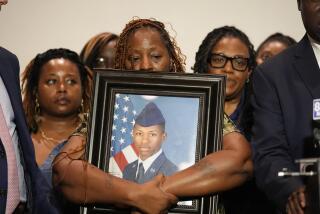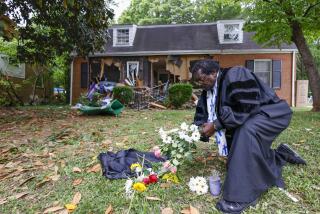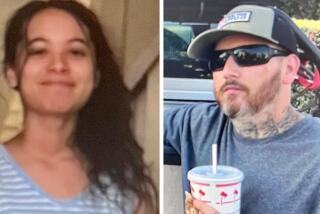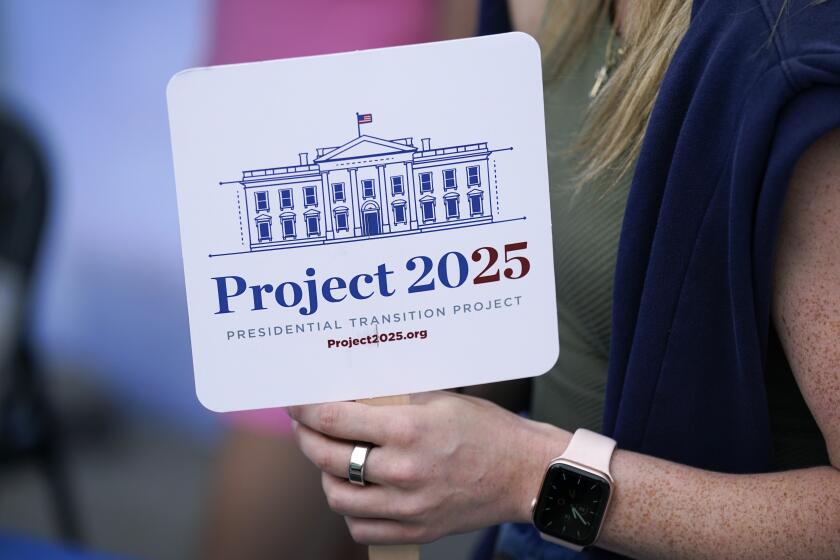S. Carolina shooting, video put race and police use of force back in the spotlight
- Share via
Reporting from North Charleston, S.C. — A video shot by a passerby has roiled this Southern city and led to a white police officer being dismissed from his job and charged with murder after he was seen firing eight shots at a fleeing black man.
The video, which went viral on Wednesday, has become the center of this Southern drama over race and the use of force by police. In a day of local protests and condolence calls by top municipal officials seeking to contain the fallout from the shooting, the White House also weighed in calling the video, filmed by a man with a cellphone, “hard to watch.”
Josh Earnest, the White House spokesman, said the bystander’s shaky handheld video of North Charleston police Officer Michael T. Slager, 33, repeatedly shooting Walter L. Scott, 50, in the back changed how investigators viewed the case.
“That is an example of how body cameras worn by police officers could have a positive impact in terms of building trust between law enforcement officers and the communities that they serve,” Earnest said.
Earnest said he did not know if President Obama had seen the graphic video, which set off a firestorm of angry protests directed at local officials.
Speaking at a news conference that was often interrupted by protesters, North Charleston Mayor Keith Summey called the shooting a tragedy for both families, the white officer’s and the black man’s. The city will continue to pay health insurance for the officer’s wife, who is eight months pregnant, he said.
“This has been a horrible tragedy within our community,” Summey said after praying earlier with the Scott family.
“Two families have been harmed by what has occurred,” the mayor said. “Our hearts go out to both of them.”
The city has also ordered additional body cameras to be worn by all officers, the mayor said, with Police Chief Eddie Driggers at his side.
“I have watched the video,” Driggers told reporters, and “I was sickened by what I saw.”
Protesters often broke into the officials’ remarks, chanting, “No justice, no peace,” a frequent slogan in the past year at demonstrations across the nation over the use of police force, particularly against African Americans.
“We understand, we don’t have any issues with that,” the mayor responded, trying to answer questions and calm the crowd, which had earlier demonstrated outside City Hall.
About 47% of the city is black and whites make up about 41% of the 104,000 residents. The police force is more than 80% white.
South Carolina is 66.2% white and 27.9% black.
Summey said the city was more than willing to hire more African Americans, but had difficulty finding recruits.
Officials also defended police officers who did not administer first aid or CPR in the moments after the shooting.
“Not every officer is CPR-certified,” the mayor said.
“Why not?” shouted back a protester.
Earlier, Scott’s family praised the video with its painful images of the man’s death.
Without the video, the shooting “would have never come to light. They would have swept it under the rug, like they did with many others,” Walter Scott Sr. said on Thursday on NBC’s “Today” show. “When I saw it ... my heart was broken.
“The way [Slager] was shooting that gun, it looked like he was trying to kill a deer. ... I don’t know whether it was racial, or it was something wrong with his head,” Scott said.
Judy Scott, the slain man’s mother, called the video “the most horrible thing I’ve ever seen.”
“I almost couldn’t look at it to see my son running defenselessly, being shot. It just tore my heart to pieces,” she said on ABC’s “Good Morning America.”
Slager, a five-year veteran of the city police force, had originally told authorities that he feared for his life during a confrontation with Scott after a traffic stop on Saturday over a faulty brake light. Scott had taken the officer’s stun gun, officials said they were told by the 33-year-old officer.
The video, however, shows the officer firing as Scott flees. Scott appears to be 15 to 20 feet away from the officer at the time, and falls at the last of eight shots. Some of the shots hit him in the back, the family’s lawyer said.
The officer then runs to where the original confrontation takes place and picks up something off the ground. Moments later, he drops an object near Scott’s body, the video shows.
Anthony Scott said he was attending an impromptu memorial service for his dead brother Sunday at the very spot where a video depicted the fatal shooting.
A young man walked up to Scott and said, “I have something to share with you,” Scott, 52, said at his parents’ home Wednesday, and produced a cellphone to play a video. Scott saw Slager fire eight times as his brother fled.
The man has since been identified as Feidin Santana during a Wednesday interview with NBC.
The man was a stranger, Scott said. He told Scott that he wanted the family to see the video because he believed the narrative of the shooting provided by police was false.
Scott said the man who showed him the video told him he took it because he was walking past and became curious when he saw Walter Scott with the officer.
“He said he would never have thought that it would go to that level,” Scott said, referring to the eight shots fired at Scott’s back.
“He cursed on the tape,” Scott said of the owner of the cellphone. “He said he couldn’t believe what he saw.’’
After he viewed the tape, Scott said, “I felt sick and angry.”
The video was provided to the family later Sunday, Scott said. He declined to provide details, but said the family made sure it ended up in the hands of the South Carolina Law Enforcement Division, known locally as SLED.
Justin T. Bamberg, a lawyer representing the Scott family, said the person who took the video gave it to the family on Sunday. It was turned over to SLED after the family called Bamberg on Sunday night and asked him to represent them, Bamberg said.
Scott and Bamberg declined to identify the person who took the video, saying he feared retribution. They also declined to specify his race, saying it was not significant. They said he might come forward at some point.
“He was in the right place at the right time for justice,’’ Bamberg said.”`He exemplifies courage. He had a strong desire to do the right thing.’’
Summey announced the murder charge at a news conference Tuesday.
“When you’re wrong, you’re wrong,” Summey told reporters. “When you make a bad decision, don’t care if you’re behind the shield or a citizen on the street, you have to live with that decision.”
The Rev. Al Sharpton on Wednesday praised the police chief and mayor for moving quickly.
“Who would believe a police chief in the Deep South would show more honesty and transparency than some of the big city police chiefs?” Sharpton said as he opened a convention of his National Action Network.
Sharpton also said the incident underscored the need for a national policy on policing that would ensure among other things that police encounters with citizens are captured on video.
“Not until the video came out yesterday did police believe” an account other than the officer’s, Sharpton said.
Unlike Ferguson, Mo., where the shooting of an unarmed young black man by a white police officer prompted weeks of sometimes violent protests last year, there has been no violent backlash in North Charleston. Pastors and community leaders have asked residents to remain calm and let the justice system prevail.
Civil rights leaders attributed the relative calm to the quick decision by local prosecutors to charge Slager.
“Because the truth came out early, it’s been fairly quiet,” said Edward Bryant III, president of the North Charleston NAACP. “It’s only when the truth stays hidden that you get violence.”
Slager made his first court appearance on Tuesday and was denied bond. If convicted, he could face 30 years to life in prison.
Slager’s former attorney, David Aylor, had released a statement Monday saying the officer felt threatened and that Scott was trying to grab Slager’s stun gun.
The FBI is also investigating the incident, the Justice Department announced. Also investigating is the South Carolina Law Enforcement Division, the state’s criminal investigative body.
Scott had been arrested about 10 times, mostly for failing to pay child support or show up for court hearings, according to the Post and Courier newspaper of Charleston. He was arrested in 1987 on an assault and battery charge and convicted in 1991 of possession of a bludgeon, the newspaper reported.
The South Carolina incident comes amid increased attention to the role of police in African American communities. The shooting of Michael Brown last year in Ferguson, Mo., led to weeks of sometimes violent protests. The death of Eric Garner on Staten Island sparked protest across New York and the nation.
Grand juries in Missouri and Staten Island decided not to charge the white officers involved in those incidents. The Staten Island case was also captured on video.
In January, prosecutors in Albuquerque, N.M., charged two police officers with murder in the shooting of a homeless man in a confrontation that was captured by an officer’s body camera. A video taken in Cleveland shows the police shooting a 12-year-old boy, Tamir Rice, who was carrying a toy gun while playing in a park.
A White House policing panel recently recommended that police departments put more video cameras on their officers.
Zucchino reported from North Charleston and Muskal from Los Angeles. Staff writers Tina Susman contributed from New York and Timothy M. Phelps contributed from Washington.
More to Read
Sign up for Essential California
The most important California stories and recommendations in your inbox every morning.
You may occasionally receive promotional content from the Los Angeles Times.












